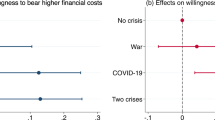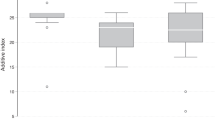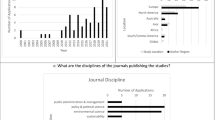Abstract
Research findings on the relationship between climate and conflict are diverse and contested. Here we assess the current understanding of the relationship between climate and conflict, based on the structured judgments of experts from diverse disciplines. These experts agree that climate has affected organized armed conflict within countries. However, other drivers, such as low socioeconomic development and low capabilities of the state, are judged to be substantially more influential, and the mechanisms of climate–conflict linkages remain a key uncertainty. Intensifying climate change is estimated to increase future risks of conflict.
This is a preview of subscription content, access via your institution
Access options
Access Nature and 54 other Nature Portfolio journals
Get Nature+, our best-value online-access subscription
$29.99 / 30 days
cancel any time
Subscribe to this journal
Receive 51 print issues and online access
$199.00 per year
only $3.90 per issue
Buy this article
- Purchase on Springer Link
- Instant access to full article PDF
Prices may be subject to local taxes which are calculated during checkout



Similar content being viewed by others
Data availability
All data generated or analysed during this study are included in this published article (and its Supplementary Information) or are available in the Stanford Digital Repository (https://purl.stanford.edu/sy632nx6578)42. The Stanford University IRB approved involvement of the human subjects in this research project. Per that approval and associated informed consent, anonymized transcript summaries are provided, but not the raw transcripts themselves.
References
Burke, M. B., Miguel, E., Satyanath, S., Dykema, J. A. & Lobell, D. B. Warming increases the risk of civil war in Africa. Proc. Natl Acad. Sci. USA 106, 20670–20674 (2009).
Adger, W. N. et al. in Climate Change 2014: Impacts, Adaptation, and Vulnerability. Part A: Global and Sectoral Aspects. (eds Field, C. B. et al.) 755–791 (Cambridge Univ. Press, 2014).
Buhaug, H. Climate not to blame for African civil wars. Proc. Natl Acad. Sci. USA 107, 16477–16482 (2010).
Hsiang, S. M., Burke, M. & Miguel, E. Quantifying the influence of climate on human conflict. Science 341, 1235367 (2013).
Buhaug, H. et al. One effect to rule them all? A comment on climate and conflict. Clim. Change 127, 391–397 (2014).
Hsiang, S. M. & Meng, K. C. Reconciling disagreement over climate–conflict results in Africa. Proc. Natl Acad. Sci. USA 111, 2100–2103 (2014).
O’Loughlin, J., Linke, A. M. & Witmer, F. D. W. Effects of temperature and precipitation variability on the risk of violence in sub-Saharan Africa, 1980–2012. Proc. Natl Acad. Sci. USA 111, 16712–16717 (2014).
Salehyan, I. Climate change and conflict: making sense of disparate findings. Polit. Geogr. 43, 1–5 (2014).
Burke, M., Hsiang, S. M. & Miguel, E. Climate and conflict. Annu. Rev. Econ. 7, 577–617 (2015).
Koubi, V., Bernauer, T., Kalbhenn, A. & Spilker, G. Climate variability, economic growth, and civil conflict. J. Peace Res. 49, 113–127 (2012).
Solow, A. R. A call for peace on climate and conflict. Nature 497, 179–180 (2013).
Cane, M. A. et al. Temperature and violence. Nat. Clim. Change 4, 234–235 (2014).
Raleigh, C., Linke, A. & O’Loughlin, J. Extreme temperatures and violence. Nat. Clim. Change 4, 76–77 (2014).
Bollfrass, A. & Shaver, A. The effects of temperature on political violence: global evidence at the subnational level. PLoS ONE 10, e0123505 (2015).
von Uexkull, N., Croicu, M., Fjelde, H. & Buhaug, H. Civil conflict sensitivity to growing-season drought. Proc. Natl Acad. Sci. USA 113, 12391–12396 (2016).
Schleussner, C. F., Donges, J. F., Donner, R. V. & Schellnhuber, H. J. Armed-conflict risks enhanced by climate-related disasters in ethnically fractionalized countries. Proc. Natl Acad. Sci. USA 113, 9216–9221 (2016).
Adams, C., Ide, T., Barnett, J. & Detges, A. Sampling bias in climate–conflict research. Nat. Clim. Change 8, 200–203 (2018).
Hendrix, C. S. Searching for climate–conflict links. Nat. Clim. Change 8, 190–191 (2018).
Levy, M. A. Sampling bias does not exaggerate climate–conflict claims. Nat. Clim. Change 8, 442 (2018).
Don’t jump to conclusions about climate change and civil conflict. Nature 554, 275–276 (2018).
Gleick, P. H., Lewandowsky, S. & Kelley, C. Climate and conflict: don’t oversimplify. Nature 555, 587 (2018).
Hsiang, S. & Burke, M. Conclusion of conflict and climate analysis questioned. Nature 555, 587 (2018).
Scheffran, J., Brzoska, M., Kominek, J., Link, P. M. & Schilling, J. Climate change and violent conflict. Science 336, 869–871 (2012).
Gleditsch, N. P. & Nordås, R. Conflicting messages? The IPCC on conflict and human security. Polit. Geogr. 43, 82–90 (2014).
Ide, T. & Scheffran, J. On climate, conflict and cumulation: suggestions for integrative cumulation of knowledge in the research on climate change and violent conflict. Glob. Change Peace Secur. 26, 263–279 (2014).
Gemenne, F., Barnett, J., Adger, W. N. & Dabelko, G. D. Climate and security: evidence, emerging risks, and a new agenda. Clim. Change 123, 1–9 (2014).
Buhaug, H. Climate–conflict research: some reflections on the way forward. Wiley Interdiscip. Rev. Clim. Change 6, 269–275 (2015).
Hendrix, C. S. The streetlight effect in climate change research on Africa. Glob. Environ. Change 43, 137–147 (2017).
Morgan, M. G. Use (and abuse) of expert elicitation in support of decision making for public policy. Proc. Natl Acad. Sci. USA 111, 7176–7184 (2014).
Morgan, M. G. & Keith, D. W. Subjective judgments by climate experts. Environ. Sci. Technol. 29, 468A–476A (1995).
Moss, R. H. & Schneider, S. H. in Guidance Papers on the Cross Cutting Issues of the Third Assessment Report of the IPCC (eds Pachauri, R. et al.) 33–51 (IPCC, 2000).
Yohe, G. & Oppenheimer, M. Evaluation, characterization, and communication of uncertainty by the Intergovernmental Panel on Climate Change: an introductory essay. Clim. Change 108, 629–639 (2011).
Pettersson, T. & Eck, K. Organized violence, 1989–2017. J. Peace Res. 55, 535–547 (2018).
Mach, K. J., Mastrandrea, M. D., Bilir, T. E. & Field, C. B. Understanding and responding to danger from climate change: the role of key risks in the IPCC AR5. Clim. Change 136, 427–444 (2016).
Mach, K. J., Mastrandrea, M. D., Freeman, P. T. & Field, C. B. Unleashing expert judgment in assessment. Glob. Environ. Change 44, 1–14 (2017).
Hegre, H. & Sambanis, N. Sensitivity analysis of empirical results on civil war onset. J. Conflict Resolut. 50, 508–535 (2006).
Mach, K. J. & Field, C. B. Toward the next generation of assessment. Annu. Rev. Environ. Resour. 42, 569–597 (2017).
Ostrom, E. Governing the Commons (Cambridge Univ. Press, 1990).
Homer-Dixon, T. F. Environment, Scarcity, and Violence (Princeton Univ. Press, 1999).
Busby, J. W., Smith, T. G. & Krishnan, N. Climate security vulnerability in Africa mapping 3.0. Polit. Geogr. 43, 51–67 (2014).
Bowlsby, D., Chenoweth, E., Hendrix, C. S. & Moyer, J. The future is a moving target: predicting political instability. Br. J. Polit. Sci. https://doi.org/10.1017/S0007123418000443 (2019).
Mach, K. J. et al. Climate as a risk factor for armed conflict data sets. https://purl.stanford.edu/sy632nx6578 (Stanford Digital Repository, 2019).
Straus, S. G., Parker, A. M., Bruces, J. B. & Dembosky, J. W. The group matters: a review of the effects of group interaction on processes and outcomes in analytic teams. Working Paper No. WR-580-USG https://www.rand.org/content/dam/rand/pubs/working_papers/2009/RAND_WR580.pdf (RAND, 2009).
Acknowledgements
We acknowledge the substantial contributions of researchers whose work was the basis of this expert assessment. G. Albistegui Adler and T. Carleton participated in trials of the elicitation protocol. This research was supported by the Alexander von Humboldt Foundation, the Stanford Woods Institute for the Environment, European Research Council grant no. 648291, the German Science Foundation Clusters of Excellence CliSAP and CliCCS, the National Science Foundation Interdisciplinary Behavioral Social Science Initiative and the Swedish Foundation for Strategic Environmental Research Mistra Geopolitics program.
Reviewer information
Nature thanks Geoff Dabelko, Vally Koubi and the other anonymous reviewer(s) for their contribution to the peer review of this work.
Author information
Authors and Affiliations
Contributions
K.J.M. and C.B.F. conceptualized the research goals. The author team of this manuscript consists of the climate and conflict expert group (W.N.A., H.B., M.B., J.D.F., C.S.H., J.-F.M., J.O., P.R., J.S., K.A.S. and N.v.U.) and the assessment facilitators (K.J.M., C.M.K. and C.B.F.). K.J.M., C.B.F. and C.M.K. developed the methodology with review and revision by the expert group (W.N.A., H.B., M.B., J.D.F., C.S.H., J.-F.M., J.O., P.R., J.S., K.A.S. and N.v.U.). K.J.M. and C.M.K. conducted the individual expert elicitation and group deliberation with the expert group and analysed the data. K.J.M. drafted the manuscript with review and revision by all authors.
Corresponding author
Ethics declarations
Competing interests
The authors declare no competing interests.
Additional information
Publisher’s note: Springer Nature remains neutral with regard to jurisdictional claims in published maps and institutional affiliations.
Extended data figures and tables
Extended Data Fig. 1 Scope of the expert assessment.
The risk of organized armed conflict within countries is shaped by interactions between the government and societal claimants (grey rounded arrows). Conflict and climate change are interconnected through climate effects on drivers of conflict (centre green/brown arrow pointing to the left). They also are interconnected through the consequences of conflict for climate-related vulnerability and exposure (centre brown arrow pointing to the right). These interactions depend on their geographical and temporal context. Against this backdrop, the assessment successively documented expert judgments across several themes: (1) drivers of conflict risk in experiences to date (grey rounded arrow on the left); (2) the relationship between climate and conflict risk to date and in the future (centre of figure); and (3) implications for adaptation to climate change and reduction in the risk of conflict (top and bottom). Throughout this figure, green arrows indicate interactions that decrease risk, whereas brown arrows indicate interactions that increase risk. Participating experts were selected to encompass a wide range of expertise on conflict, climate or their combination. Figure illustration by K. Marx.
Extended Data Fig. 2 Individual expert judgments about the relationship between climate and conflict risk.
Raw numbers of the subjective probabilistic estimates of each expert that are documented in the elicitation. For each expert, the first 6 rows correspond to the 6 causal factors that the expert ranked as most influencing conflict risk to date, drawing from a list of 16 factors collectively generated by the full expert group. The last 3 rows correspond to past examples of organized armed conflict overall (labelled as ‘past’) and to conflict risk under approximately 2 °C and approximately 4 °C warming scenarios (labelled as 2 °C and 4 °C). Numbers within each row are estimated probabilities. For each causal factor (the first six rows), the probabilities reflect judgments of how frequently climate variability and change have led to substantial, moderate or negligible changes in conflict risk for violent conflicts to date involving that factor (probabilities ordered as: substantial decrease, moderate decrease, negligible change, moderate increase and substantial increase). For total risk of violent conflict to date (past), the probabilities reflect judgments across past examples of conflict overall. For the approximately 2 °C and approximately 4 °C warming scenarios, specified probabilities reflect judgments of potential changes in conflict risk compared to the current climate; these hypothetical scenarios consider effects for current societies, assuming current levels of (for example) socioeconomic development, population and government capacity. Shading categories visualize patterns. CN, conflict in neighbouring areas; CR, corruption; ES, economic shocks; EI, external intervention; ID, illiberal democracy; II, intergroup inequality; MG, mistrust of government; NR, natural resource dependency; PG, physical geography; PP, population pressure; PS, political shocks; RH, recent history of violent conflict; SC, low state capability; SD, low socioeconomic development; VC, climate variability and/or change; VI, vertical income inequality. Confidence levels37 are indicated in the rightmost column: vl, very low; l, low; m, medium; h, high; vh, very high.
Extended Data Fig. 3 Before–after comparisons of elicited expert judgments.
After the group deliberation, each expert individually revisited his or her judgments from the individual expert elicitation, updating them in some cases. All adjustments made are depicted here and in Extended Data Fig. 4. Across expert-elicitation interview questions, individual updates following the group deliberation are modest. This figure indicates individual expert judgments about the relationship between climate and conflict risk for the 6 most influential factors ranked by each expert, for conflicts to date overall, and for the 2 °C and 4 °C warming scenarios for current societies overall. Data are the initial judgments of each expert during the individual expert-elicitation interviews. Estimates updated after the group deliberation (see Extended Data Fig. 2 for final estimates) are shown in red.
Extended Data Fig. 4 Before–after comparisons of elicited expert judgments.
After the group deliberation, each expert individually revisited his or her judgments from the individual expert-elicitation interviews, updating them in some cases. All adjustments made are depicted here and in Extended Data Fig. 3. Across expert-elicitation interview questions, individual updates following the group deliberation are modest. a–d, In these plots, initial judgments during the individual expert-elicitation interviews are compared to the revisited judgments that were updated in some cases. In cases in which judgments are updated, figure panels are repeated, showing the initial estimates in grey (a repeats Fig. 1, b repeats Fig. 2, c repeats Extended Data Fig. 6a and d repeats Extended Data Fig. 7). Detailed descriptions of each panel and the symbols used are provided in the legends of Figs. 1, 2 and Extended Data Figs. 6a, 7.
Extended Data Fig. 5 Individual expert judgments regarding the climate sensitivity and increase/decrease ratio for the relationship between climate and conflict risk.
For each expert, two measures were used to characterize elicited judgments about the relationship between climate and conflict risk: climate sensitivity and increase/decrease ratio. a, Sensitivity and increase/decrease ratio are shown for the six most influential conflict drivers that were considered by an expert (light blue; mean across causal factors) and for past examples of violent conflict overall (dark blue). b, Sensitivity and increase/decrease ratio are shown for conflict risk overall under the 2 °C (orange) and 4 °C (red) scenarios. Numbers indicate the expert identifier for each data point. A comparison of blue to orange to red data points indicates that they shift to the right and upwards. This shift illustrates the overall judgment that, with intensifying climate change, climate is expected to increasingly affect conflict risk (illustrated by greater sensitivity—that is, the upward shift). Additionally, this effect will increasingly serve to intensify rather than diminish conflict risk (illustrated by the greater increase/decrease ratio—that is, the shift to the right). For full definitions of the climate sensitivity and increase/decrease ratio measures, see Methods.
Extended Data Fig. 6 Expert judgments regarding the climate sensitivity and increase/decrease ratio of the most influential conflict drivers.
Two measures are used to characterize elicited judgments about the relationship between factors that drive conflict risk and climate in experiences to date: climate sensitivity and increase/decrease ratio. a, Sensitivity and increase/decrease ratio are shown for each causal factor (mean across experts; causal factor abbreviations as in Extended Data Fig. 2). The size of each data point indicates the number of experts who ranked the causal factor in their top-six-factor list. b, c, Mean sensitivity and increase/decrease ratio are repeated for each factor from a, shown as circles. For each factor, the range indicates the maximum and minimum sensitivity (b) and increase/decrease ratio (c) across the 11 experts. a, c, For causal factors with 100% estimated for negligible change (sensitivity = 0), the increase/decrease ratio is assigned a value of 0.5. b and c are repeated from Fig. 3, but with different sorting of factors, to enable comparison with a. For full definitions of the climate sensitivity and increase–decrease measures, see the legend of Fig. 3 and Methods.
Extended Data Fig. 7 Estimated potential to reduce climate-related conflict risk.
For three scenarios (experiences to date and the 2 °C and 4 °C warming scenarios), each expert estimated the reduction in climate-related conflict risk that could occur with substantial investments in conflict risk reduction. Probability estimates are indicated for substantial decrease in conflict risk, moderate decrease in conflict risk or negligible change. Substantial investments include measures and policies that address known conflict drivers, which are expected to contribute to risk reduction. For past examples of organized armed conflict overall (blue), probability estimates indicate a risk reduction deficit34. For the 2 °C and 4 °C warming scenarios presented here, probability estimates assume that the global mean warming levels are reached in the second half of the twenty-first century. Probability estimates encompass the range of socioeconomic development pathways that could occur over that timeframe. Open circles, individual estimates; filled circles, means across experts.
Supplementary information
Supplementary information
The supplementary information contains four tables summarizing expert judgments from the individual expert-elicitation interviews and the group deliberation. Supplementary Table 1: Drivers of organized armed conflict. Supplementary Table 2: Climate–conflict linkages to date and in the future. Supplementary Table 3: Climate–conflict implications for conflict risk reduction and climate change adaptation. Supplementary Table 4: Analytical challenges in evaluating conflict and the role of climate
Rights and permissions
About this article
Cite this article
Mach, K.J., Kraan, C.M., Adger, W.N. et al. Climate as a risk factor for armed conflict. Nature 571, 193–197 (2019). https://doi.org/10.1038/s41586-019-1300-6
Received:
Accepted:
Published:
Issue Date:
DOI: https://doi.org/10.1038/s41586-019-1300-6
This article is cited by
-
Exploring the water–food nexus reveals the interlinkages with urban human conflicts in Central America
Nature Water (2023)
-
Drought exposure decreases altruism with salient group identities as key moderator
Nature Climate Change (2023)
-
Low-carbon warfare
Nature Climate Change (2023)
-
Climate change and conflict
Nature Reviews Earth & Environment (2023)
-
Intraday adaptation to extreme temperatures in outdoor activity
Scientific Reports (2023)
Comments
By submitting a comment you agree to abide by our Terms and Community Guidelines. If you find something abusive or that does not comply with our terms or guidelines please flag it as inappropriate.



